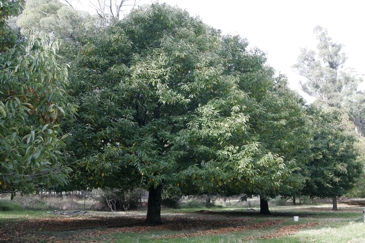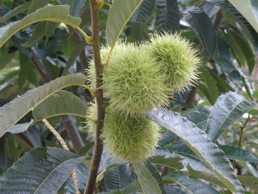| Perennial / Desiduous Trees / Chestnut / Castanea / Big Sweet Chestnut |
|
|
|
|
| |
|
Plant name - Chestnut - Castanea sativa
|

|
|
 |
|
 |
| Common name - Chestnut
|
| Plant type - Desiduous |
| Vegetation type -
Perennial |
| Growth rate - Medium |
| Leaf / Flower color
- Green / Green |
| Other names - sweet big / European chestnut
|
| |
| Description : |
The chestnut belongs to the same family as the oak and beech. The four main species are commonly known as European, Chinese, Japanese and American chestnuts, some species called chinkapin or chinquapin:
European species sweet chestnut (Castanea sativa) (also called "Spanish chestnut" in the US) is the only European species of chestnut, though was successfully introduced to the Himalayas and other temperate parts of Asia. Unrelated, but externally similar species of horse chestnut are abundant around Europe.
Asiatic species Castanea crenata (Japanese chestnut), Castanea mollissima (Chinese chestnut), Castanea davidii (China), Castanea henryi (Chinese chinkapin, also called Henry's chestnut – China) and Castanea seguinii (also called Seguin's chestnut – China)
American species These include Castanea dentata (American chestnut – Eastern states), Castanea pumila (American- or Allegheny chinkapin, also known as "dwarf chestnut" – Eastern states), Castanea alnifolia (Southern states), Castanea ashei (Southern states), Castanea floridana (Southern states) and Castanea paupispina (Southern states).
.
|
| |
| Growing Instructions : |
* Find a suitable spot for planting. The Chestnut needs to be grown in full sunlight, well-drained soil, a slope facing anywhere from north to east, and not high elevation. During this time of restoration, it is important that you do not stress the tree until a few generations of them have grown resistant to the blight. Dig a hole about 2 feet deep and fill it halfway with leaf mulch, sand and peat moss. Mark it for easy identification in the spring. (This can also be done in the spring before transplanting)
* The seeds will need a few months of cold before they will sprout, so any seeds received in October should be refrigerated until February. Pack them with peat moss in a container like a plastic bag with tiny pinholes for ventilation. Check them weekly for mold or mildew.
* Make a newspaper cone about 12 inches deep and 3 inches wide, stapled at the bottom in early spring and fill it with a 50/50 mixture of sand and peat moss. Plant a chestnut on its side about 1 inch down and cover with soil. Place the cone in a plastic container in a sunny window. Water it regularly and wait for it to sprout.
* Transplant the seedling carefully into the hole outside that you previously prepared. Carefully cut open the bottom of the newspaper cone and bury the whole thing. Water it weekly during the first year. Keep in mind that you will need to plant at least two trees for pollination and they should be about 10 feet apart. Use a tree shelter to protect it from deer and raccoons.
|
| |
|
|
|
|
|
